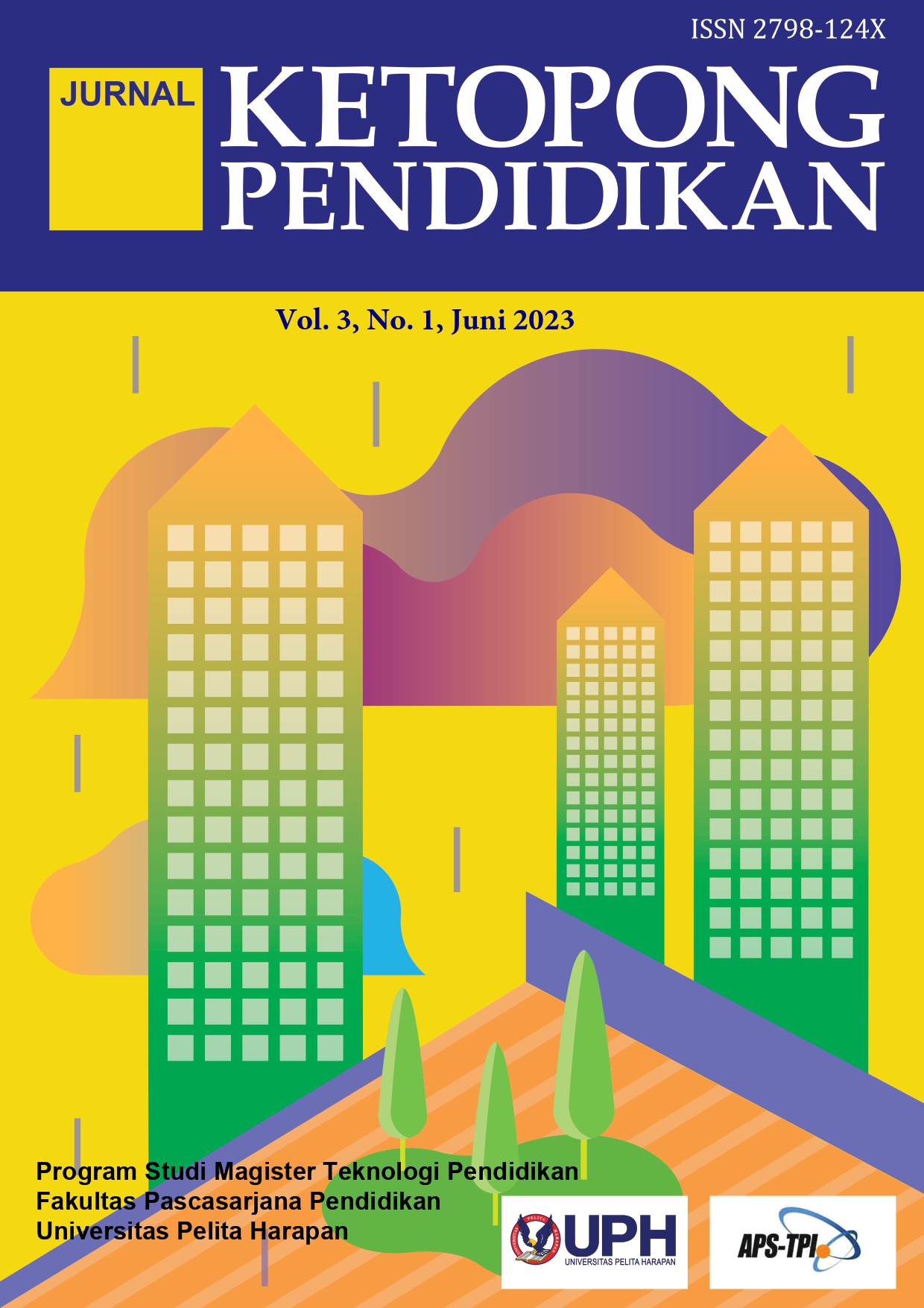Pengaruh Structural Empowerment, Leader Empowerment, dan Psychological Empowerment terhadap Innovative Behavior Guru di SMK XYZ Jakarta
DOI:
https://doi.org/10.19166/jkp.v3i1.10412Trefwoorden:
behavior, empowerment, innovative, leader, psychological, structuralSamenvatting
Innovative behavior is an important factor in improving teachers’ performance. An individual who is innovative is able to seek and discover new ways of accomplishing tasks more effectively and efficiently. However, innovation can only grow within a person if they work in an environment that supports its development. The purpose of this study is to examine the influence of structural empowerment, leader empowerment, and psychological empowerment on teachers’ innovative behavior. The subjects of this research were thirty five teachers from SMK XYZ located in South Jakarta. The research design used was correlational, employing a survey to collect data, which was then analyzed using the PLS-SEM method. The results indicate that structural empowerment, leader empowerment, and psychological empowerment have a positive influence on teachers’ innovative behavior.
Referenties
Bani-Melhem, S., Zeffane, R., & Albaity, M. (2018). Determinants of employees’ innovative behavior. International Journal of Contemporary Hospitality Management, 30(3), 1601–1620. https://doi.org/10.1108/IJCHM-02-2017-0079
Bean, R. & Russell W. R. (2006). The business of innovation. New York: AMACOM.
Chen, Y., Liu, B., Zhang, L., & Qian, S. (2018). Can leader “humility” spark employee “proactivity”? The mediating role of psychological empowerment. Leadership & Organization Development Journal, 39(3), 326–339. https://doi.org/10.1108/LODJ-10-2017-0307
Chow, I. H. S. (2018). The mechanism underlying the empowering leadership-creativity relationship. Leadership & Organization Development Journal, 39(2), 202–217. https://doi.org/10.1108/LODJ-03-2016-0060
Dahinten, V. S., Lee, S. E., & MacPhee, M. (2016). Disentangling the relationships between staff nurses’ workplace empowerment and job satisfaction. Journal of nursing management, 24(8), 1060–1070. https://doi.org/10.1111/jonm.12407
Dan, X., Xu, S., Liu, J., Hou, R., Liu, Y., & Ma, H. (2018). Relationships among structural empowerment, innovative behaviour, self‐efficacy, and career success in nursing field in mainland China. International journal of nursing practice, 24(5), e12674. https://doi.org/10.1111/ijn.12674
Dash, S. S., & Vohra, N. (2019). The leadership of the school principal: Impact on teachers’ job crafting, alienation and commitment. Management Research Review, 42(3), 352–369. https://doi.org/10.1108/MRR-11-2017-0384
Dedahanov, A. T., Rhee, C., & Yoon, J. (2017). Organizational structure and innovation performance: Is employee innovative behavior a missing link? Career Development International, 22(4), 334–350. https://doi.org/10.1108/CDI-12-2016-0234
Dunnette, M. D. & Hough L. M. (2002). Handbook of industrial and organizational psychology. Palo Alto, CA.: Consulting Psychologists Press,.
George, E., & Zakkariya, K. A. (2018). Psychological empowerment and job satisfaction in the banking sector. Springer International Publishing / Palgrave Pivot.
Ghozali, I. (2014). Structural equation modeling metode alternatif dengan Partial Least Square (PLS)(4th ed.). Semarang: Badan Penerbit UNDIP.
Ghozali, I. & Hengky L. (2015). Partial least square: Konsep, teknik dan aplikasi menggunakan program SmartPLS 3.0 (2nd ed.). Semarang: Badan Penerbit UNDIP.
Gkorezis, P. (2016). Principal empowering leadership and teacher innovative behavior: a moderated mediation model. International journal of educational management, 30(6), 1030–1044. https://doi.org/10.1108/IJEM-08-2015-0113
Hirzel, A.-K., Leyer, M., & Moormann, J. (2017). The role of employee empowerment in the implementation of continuous improvement: Evidence from a case study of a financial services provider. International Journal of Operations & Production Management, 37(10), 1563–1579. https://doi.org/10.1108/IJOPM-12-2015-0780
Horwitz, S. K., & Horwitz, I. B. (2017). The effects of organizational commitment and structural empowerment on patient safety culture: an analysis of a physician cohort. Journal of health organization and management, 31(1), 10–27.
Jones, G. R. (2007). Organizational theory, design, and change (5th ed.). Pearson Prentice Hall.
Kim, M.-S., & Koo, D.-W. (2017). Linking LMX, engagement, innovative behavior, and job performance in hotel employees. International Journal of Contemporary Hospitality Management, 29(12), 3044–3062. https://doi.org/10.1108/IJCHM-06-2016-0319
Kundu, S. C., Kumar, S., & Gahlawat, N. (2019). Empowering leadership and job performance: mediating role of psychological empowerment. Management Research Review, 42(5), 605–624. https://doi.org/10.1108/MRR-04-2018-0183
Singh, M., & Sarkar, A. (2019). Role of psychological empowerment in the relationship between structural empowerment and innovative behavior. Management Research Review, 42(4), 521–538. https://doi.org/10.1108/MRR-04-2018-0158
Sinha, S., Priyadarshi, P., & Kumar, P. (2016). Organizational culture, innovative behaviour and work related attitude: Role of psychological empowerment. Journal of Workplace Learning, 28(8), 519–535. https://doi.org/10.1108/JWL-06-2016-0055
Tidd, J. & John, B. (2013). Managing innovation: Integrating technological, market and organizational change. Wiley.
##submission.downloads##
Gepubliceerd
Nummer
Sectie
Licentie
Copyright (c) 2025 Okti Kurniasih

Dit werk wordt verdeeld onder een Naamsvermelding-GelijkDelen 4.0 Internationaal licentie.
Authors who publish with this journal agree to the following terms:
1) Authors retain copyright and grant the journal right of first publication with the work simultaneously licensed under a Creative Commons Attribution License (CC-BY-SA 4.0) that allows others to share the work with an acknowledgement of the work's authorship and initial publication in this journal.
2) Authors are able to enter into separate, additional contractual arrangements for the non-exclusive distribution of the journal's published version of the work (e.g., post it to an institutional repository or publish it in a book), with an acknowledgement of its initial publication in this journal.
3) Authors are permitted and encouraged to post their work online (e.g., in institutional repositories or on their website). The final published PDF should be used and bibliographic details that credit the publication in this journal should be included.


